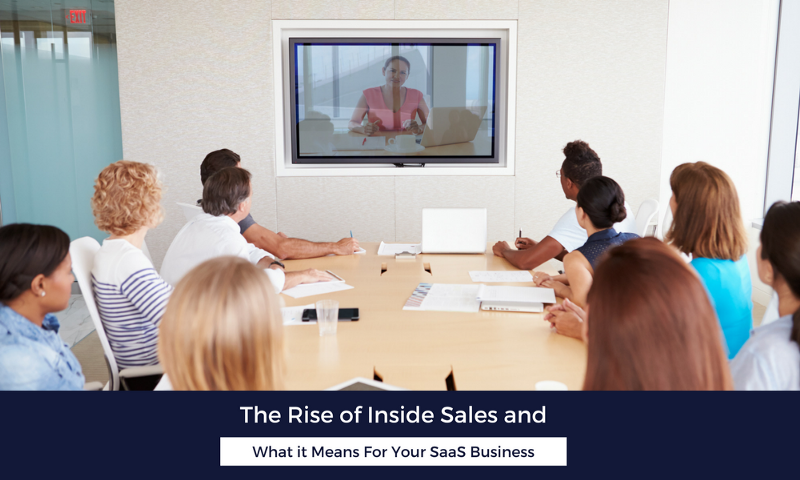
I love a long client lunch as much as the next sales rep…
But the reality is, the days of the heavy-hitting enterprise sales rep going out and spending a whole bunch of money on the corporate AMEX are over. We’re ushering in this new trend of “inside sales”.
The inside sales model is growing 15 times faster than the traditional sales model.
Inside sales is about the sale of a product or service by sales professionals who are reaching customers via phone or online, rather than travelling out to meet them face-to-face, and it is taking over field sales as the major contributor of revenue in many industries.
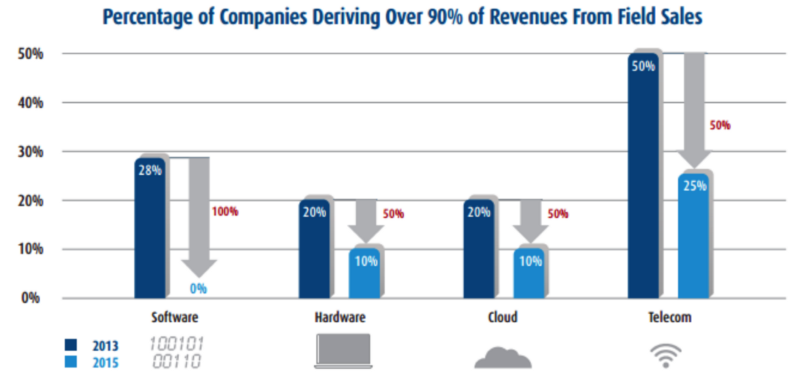
Source: The Trend Changing the Sales Landscape, Velocify
They are achieving what they need, or at least a large proportion of what they need to, without hitting the road.
There are five key trends accelerating the rise of inside sales, let’s take a look at each of them:
1. Consumers behaviour is changing
People are now very used to making purchase decisions online. They are taking their consumer experiences with online shopping and wanting the same digital experience when they make B2B purchases in their 9 to 5 jobs.
These B2B purchases are also happening at a new speed. Gone are the days where you would call someone up and schedule a meeting in a week’s time. They want it yesterday. These accelerated purchases are fueled by an explosion of information and content. B2B buyers crave information at every step of the journey so that they can move through an accelerated buying process.
B2B buyers crave information at every step of the journey so that they can move through an accelerated buying process.
These buyers also want a memorable experience. Everything that they are experiencing on social media, from Facebook to Instagram to SnapChat and LinkedIn… All of these experiences are sensory.
You are taking people on an emotional journey and educating them through stories and interesting content. That’s what is expected in B2B sales today.
2. Your customers are expecting more
With the great work being done in the consumer space from companies such as Amazon and Zappos, it is putting pressure back on B2B companies to lift their game. These companies are creating an amazing buying experience that is instant, memorable, and online-centric.
B2B sales has been left behind.
What’s being created is this huge sales-innovation gap, where B2B sales really needs to improve in order to meet the demands of their customers.
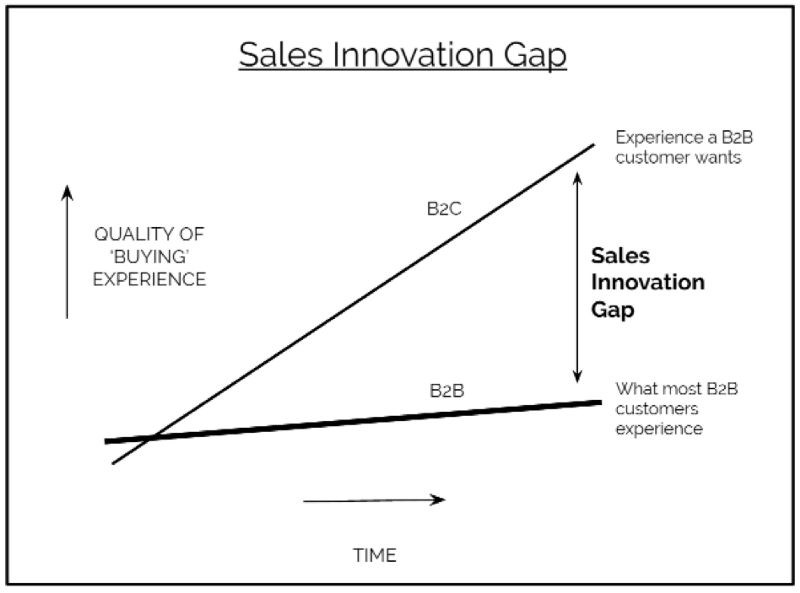
There is a lot that B2B companies can learn from these B2C companies that are delivering a first-class sales experience. It’s predominantly happening in a digital landscape and it’s powered by high-quality content and automated personalisation.
3. SaaS based technology is empowering sales teams
The third trend that is driving the rise of inside sales is the explosion of SaaS based technologies to improve the sales process.
In a similar way to how marketing technologies began to rapidly improve about 10 years ago, there is an evolution of sales technology happening now. Technological advancements that improve sales productivity and reduce sales cycles are changing the way B2B sales professionals approach their work.
This influx of sales technology and tools is not only improving a rep’s ability to reach more people at a faster rate, but it is also giving you more data to measure, track and optimise. That means you can better test and iterate at every stage of your sales process and continue to evolve and improve.
4. Relationships are different
Personal connections is one thing that hasn’t changed… But due to the growth of social networks, the way that people create these connections has evolved.
No longer do you have to meet someone at a BBQ, on a golf course or at a networking dinner to know enough about them to be able to make a personal connection.
The building blocks of personal connections — someone’s interests, hobbies, the type of content they like, the movies they watch — it’s all available online. You can leverage this availability of information to create a personal connection and build a relationship in the digital world.
Even with inside sales there is inevitably going to be a stage where you go out into the field and meet someone, but by that stage the trust and credibility will already be there. Social media has accelerated the pace at which sales reps can develop meaningful relationships with prospects.
Social media has accelerated the pace at which sales reps can develop meaningful relationships with prospects.
5. Business models are changing
There is a huge change in business models at the moment, and it’s driving everyone more towards their customer. It’s the rise of everything “subscription service”, especially in relation to software.
But we’re also seeing the subscription service economy permeating into all other sorts of industries. You can get your laundry cleaned and delivered every month, you can buy your dog food on a subscription model, you can even have razor blades delivered to your door on a subscription service model.
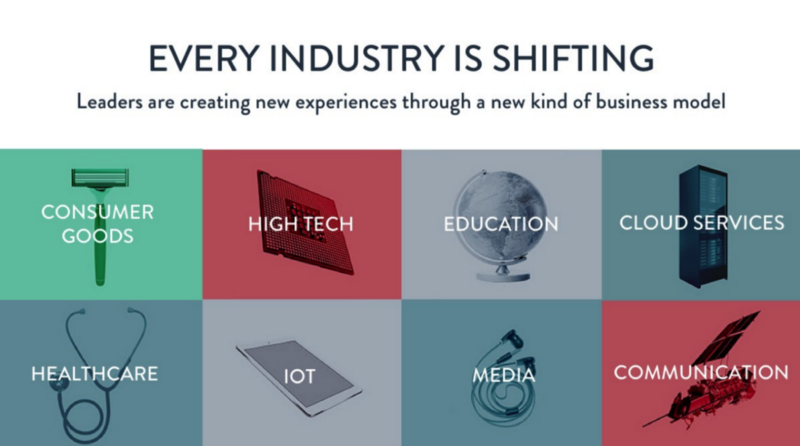
Source: Zuora
This trend is having a huge impact in the B2B space. You no longer have to create or release a huge amount of budget for a large up-front contract which will depreciate over time. So instead of software investments coming out of capital expenditure, they are coming out of operational expenses and renewing on a monthly basis. This has a massive positive effect on a business’s cash flow.
So as a salesperson, these smaller deal sizes can drastically shorten your sales cycle. Companies don’t need to make such big financial purchase decisions, so more people in the organisation are empowered to make them as well.
The business case for inside sales
There is obviously a number of big drivers in the rise of inside sales. Starting with the consumer, to technological advancements, and then with business model changes as well.
But from the organisation’s perspective, there is a really solid business case for pursuing inside sales too. Let’s take a look at what that is…
Field sales reps are expensive
Old school “field” sales reps are expensive.
Traditionally a salesperson is a lone wolf, alone out in the field, commanding a huge salary. Along with that huge salary they have a large expense account. You are paying for flights, for fuel in their car, their shiny new shoes, and a lot of client entertainment.
The worst thing about all of those expenditures is that they are really tough to measure and manage. Your field rep might only be having two meetings a day, so you can only gather meaningful data from two interactions in order to help them improve and get better results.
Plus, these meetings are extremely hard to measure and monitor. They are all happening on the customer’s turf, so you are reliant on the sales rep and their personal feedback in order to see how things are going.
In this situation the success of your business is reliant on the performance of your most skilled salespeople. They are carrying the burden of poorer performing reps, because it’s really hard to replicate and scale a rainmaker. The process is very flimsy and not repeatable.
You operate in a global marketplace
The beauty of an inside sales team is that you’re not tied to a physical location. We’re seeing a rise of remote sales teams permeating through a lot of technology organisations throughout the world. This trend will more than likely begin to infiltrate other industries as well.
Remote sales professionals work from their own environment, perhaps their home or a local office. This means you can hire the best talent wherever they are located in the world. You are not tied to a geographic location near your office or near your customers.
The reason companies can do this is because technology has enabled a truly global workplace. The same tools and technology that you have for your sales rep sitting in Perth, are exactly the same as your account manager in Singapore, or your Customer Success Manager in San Diego. They can all be measured by the same metrics and go through the same training sessions, because everything is cloud based and online.
Great talent has never been more accessible.
As well as hiring great talent all over the world, you can also sell to businesses all over the world. It’s that whole concept of “Build local and think global”. As long as you are willing to adjust your sleeping patterns, you can literally sell anywhere you want.
People are now understanding that they operate in a global marketplace. They will accept calls and conversations from people from other cultures, with weird and funny accents. As long as you are respectful, you research those other cultures and understand their business problems, you can help them just as well as anyone within your own country.
Inside sales brings increased efficiency
The last thing, which is perhaps the most important benefit of inside sales, is the increased efficiency of your sales process. By having a defined sales process with shorter sales cycles, you can continually iterate and improve, move the dead wood and get better results much quicker.
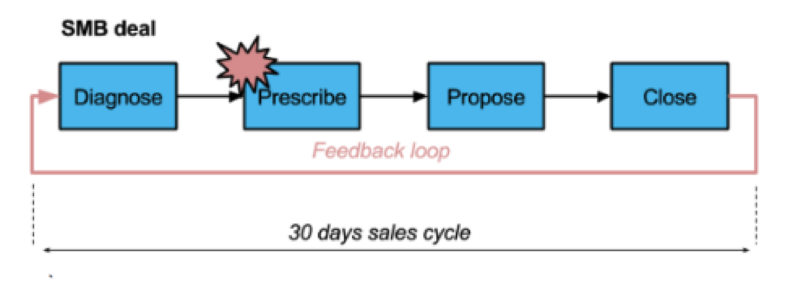
Source: Jacco van der Kooij — Are you ready to go upstream?
For example, if you’re in the old enterprise world of 12-month sales cycles, a deal falling over at the 11th month can be catastrophic. And even if you pinpoint exactly why that deal fell over, it may be two or three engagements before you can actually meaningfully change the sales process. By that stage it might be too late to save your quarter or year.
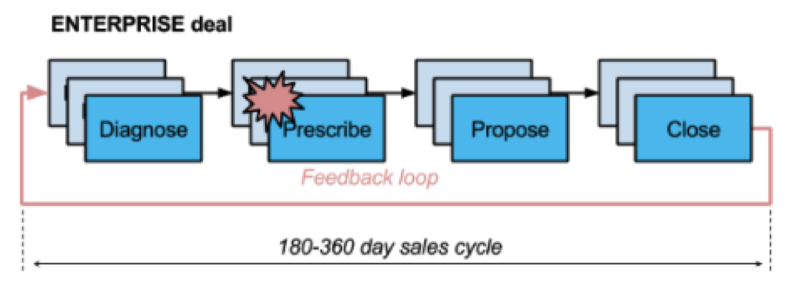
Source: Jacco van der Kooij — Are you ready to go upstream?
With inside sales, your sales cycle is more likely to be between 30 to 90 days, so you can take those learnings and quickly apply them to other engagements more quickly.
This rapid iteration is an opportunity to get more practice in, which is one of the major downfalls of field sales organisations who are only getting 5–10 meetings a week.
If you take away all of the travelling time, you can simply focus on the velocity of your sales process. It also all becomes easier to manage. Seeing the sales activity predominantly happens on the phone or online, you get a physical and impartial output that others can learn from.
Conclusion
There’s always going to be an element of relationships that influence a B2B sales decision. But the days of that relationship being 100% developed over an expensive dinner or a round of golf are diminishing.
More and more relationships are going to be developed online, over the phone or on a video call.
This is a huge opportunity for businesses to leverage the latest trends and technology to create efficiencies in their sales process with a data driven approach to sales success.
Once companies begin the journey it makes it easier to constantly iterate your process as your customer and business evolves, and ultimately build a cost effective inside sales model with the best global talent.
How has inside sales effected your sales process?


